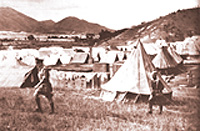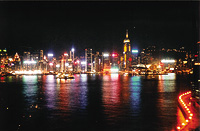|
Best of the East...
|
|
 Paul Catchik Chater, a Christian Armenian from Calcutta, also made significant contributions to the growth and development of Hong Kong. Chater arrived in Hong Kong in 1864 at the young age of 18. Starting as a bank clerk, he soon had a finger in every kind of profitable pie-wharfing, electricity, rope-making, trams, banking, hotels and land. His Hong Kong and Kowloon Wharf and Godown Company became Hong Kong’s chief dock operators. An Anglophile and enthusiastic royalist Chater splurged in all the right activities, he was conspicuously rich and built a vast palace in Hong Kong. Paul Catchik Chater, a Christian Armenian from Calcutta, also made significant contributions to the growth and development of Hong Kong. Chater arrived in Hong Kong in 1864 at the young age of 18. Starting as a bank clerk, he soon had a finger in every kind of profitable pie-wharfing, electricity, rope-making, trams, banking, hotels and land. His Hong Kong and Kowloon Wharf and Godown Company became Hong Kong’s chief dock operators. An Anglophile and enthusiastic royalist Chater splurged in all the right activities, he was conspicuously rich and built a vast palace in Hong Kong.
Among the Indian business community, the Parsees were perhaps the earliest to settle down and start business. They came along with the British from Canton in the mid 1800s. Supremely Occidental, Parsees were loved by the British for their club etiquette, Western attitudes, philanthropy and fondness for things imperial. In 1880, Dorabjee Naorojee began the Star Ferry Services between Hong Kong and Kowloon that was the precursor to today’s Star Ferry. Sir H.N. Mody, a successful Parsi merchant and stockbroker, donated HK$180,000 to help set up the University of Hong Kong in 1911. Mody along with Paul Chater established the Hong Kong Stock Exchange. Mody’s portrait adorns the Senate Hall of Hong Kong and a road in Kowloon had been named after him. He also established the Seamon’s Institute at Wanchai and made donations to the Imperial Cancer Research Fund and the National Society for the Prevention of Cruelty to Children.
|
| When the Chinese started to manufacture, Indians found the export outlet for their goods. Indian merchants explored and opened markets for Hong Kong
|
|
During Japanese occupation, among those who were tortured were two leading members of the Indian community, Ruttonjee and his son. The Japanese had tried to get the former to become president of an Indian Independence League, but he refused steadfastly to collaborate. Ruttonjee’s philanthropic activities are still remembered in the territory. The Ruttonjee Sanitarium and Freni Memorial Convalescent Home are standing testimony to his contributions. The Parsees could not hold ground from the 1970s. Today their number has considerably declined.
During the incipient years of Hong Kong’s rise, quite a few Indians made their mark in the corporate sector. Indians were members of the board of directors of leading corporations such as Hong Kong and Kowloon Wharfs and Godown Company, Hong Kong Land Investment Company, Hong Land Reclamation Company etc. The first bank to be opened in Hong Kong in 1845 was the branch of an Indian bank, the Oriental Bank of Calcutta. In the provisional committee set up in 1864 to establish the Hong Kong and Shanghai Banking
Corporation , three of its members were Indians. E.R. Belilios of Jewish origin, who had some Indian connection, was one of the earliest chairman of the Hong Kong and Shanghai Banking Corporation. Much of Belilios’ Hong Kong business was based on Indian contacts. , three of its members were Indians. E.R. Belilios of Jewish origin, who had some Indian connection, was one of the earliest chairman of the Hong Kong and Shanghai Banking Corporation. Much of Belilios’ Hong Kong business was based on Indian contacts.
The Sindhis, who constitute the bulk of the Indian population, arrived in Hong Kong in the post-war years. The 1950s, however, witnessed the exodus of Indians to Hong Kong in the wake of the partition of the Indian subcontinent. The Indian community contributed their might for the prosperity of the colony. When the Chinese started to manufacture, Indians found the export outlet for the manufactured goods. Indian merchants explored and opened markets for Hong Kong goods in the Middle East, the Gulf, the West and East Africa.
|
|
|
|
more...
|
|
|
|
February 2007
|
|

|
|
|
|